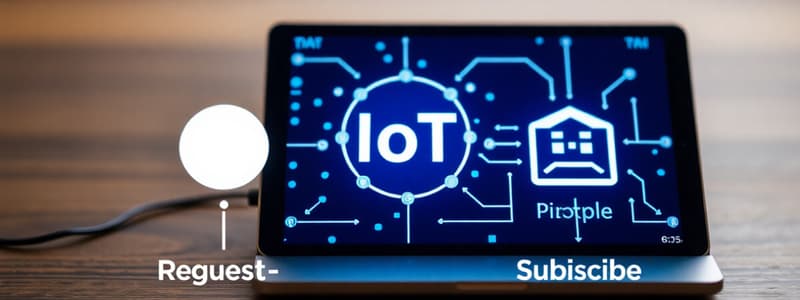Podcast
Questions and Answers
What is a key characteristic of the Publish-Subscribe communication model?
What is a key characteristic of the Publish-Subscribe communication model?
- Producers can directly interact with the consumers.
- Consumers must know about the publishers directly.
- Brokers manage the topics without the publishers' awareness. (correct)
- Publishers manage the queues for consumer access.
Which statement accurately describes the Push-Pull communication model?
Which statement accurately describes the Push-Pull communication model?
- Producers must be aware of the consumers to send data.
- Data is always pulled in real time without buffering.
- Consumers push data to producers through a broker.
- Queues serve as a decoupling mechanism between producers and consumers. (correct)
What is crucial to the operation of the Exclusive Pair communication model?
What is crucial to the operation of the Exclusive Pair communication model?
- The use of multiple connections for clients and servers.
- A temporary connection that closes automatically.
- A persistent connection remains open until closed by the client. (correct)
- A prior acknowledgment from consumers before data transmission.
Which is a defining feature of REST APIs?
Which is a defining feature of REST APIs?
In the context of IoT Communication Models, how do servers respond to requests in a Request-Response model?
In the context of IoT Communication Models, how do servers respond to requests in a Request-Response model?
What is a primary characteristic of a Level-1 IoT system?
What is a primary characteristic of a Level-1 IoT system?
Which IoT level is characterized by cloud storage and local data analysis?
Which IoT level is characterized by cloud storage and local data analysis?
In which IoT level is the analysis requirement computationally intensive?
In which IoT level is the analysis requirement computationally intensive?
Which component of an IoT system facilitates communication between the device and other components?
Which component of an IoT system facilitates communication between the device and other components?
What best describes the data storage in a Level-4 IoT system?
What best describes the data storage in a Level-4 IoT system?
What is a distinguishing feature of a Level-2 IoT system compared to Level-1?
What is a distinguishing feature of a Level-2 IoT system compared to Level-1?
Which of the following is NOT a function of the analysis component in an IoT system?
Which of the following is NOT a function of the analysis component in an IoT system?
Which HTTP method is typically used to delete a resource in REST APIs?
Which HTTP method is typically used to delete a resource in REST APIs?
What characteristic of REST APIs simplifies scalability and caching?
What characteristic of REST APIs simplifies scalability and caching?
Which format is NOT commonly used for representing resources in REST APIs?
Which format is NOT commonly used for representing resources in REST APIs?
Which statement best describes the purpose of hypermedia links in REST APIs?
Which statement best describes the purpose of hypermedia links in REST APIs?
What do REST APIs use to identify resources?
What do REST APIs use to identify resources?
In the context of IoT, what is the main function of a controller service?
In the context of IoT, what is the main function of a controller service?
Which best describes the communication model of WebSocket APIs?
Which best describes the communication model of WebSocket APIs?
Which of the following statements about REST APIs is true?
Which of the following statements about REST APIs is true?
Flashcards
Request-Response Communication Model
Request-Response Communication Model
Involves a client sending requests to a server, and the server responding to those requests. The server processes the requests, retrieves data, prepares the response, and sends it back to the client.
Publish-Subscribe Communication Model
Publish-Subscribe Communication Model
A communication model where publishers send data to topics managed by a broker, and consumers subscribe to these topics to receive the data. Publishers are not aware of consumers.
Push-Pull Communication Model
Push-Pull Communication Model
A model where producers push data to queues, and consumers pull data from these queues. Producers don't need to know about consumers. Queues act as buffers, decoupling producers and consumers.
Exclusive Pair Communication Model
Exclusive Pair Communication Model
Signup and view all the flashcards
REST (Representational State Transfer)
REST (Representational State Transfer)
Signup and view all the flashcards
What is a Level-1 IoT System?
What is a Level-1 IoT System?
Signup and view all the flashcards
What is the Analysis Component in an IoT System?
What is the Analysis Component in an IoT System?
Signup and view all the flashcards
What is a Web Service in an IoT System?
What is a Web Service in an IoT System?
Signup and view all the flashcards
What is the Database in an IoT System?
What is the Database in an IoT System?
Signup and view all the flashcards
What is a Level-2 IoT System?
What is a Level-2 IoT System?
Signup and view all the flashcards
What is a Level-3 IoT System?
What is a Level-3 IoT System?
Signup and view all the flashcards
What is a Level-4 IoT System?
What is a Level-4 IoT System?
Signup and view all the flashcards
What are resources in REST APIs?
What are resources in REST APIs?
Signup and view all the flashcards
How do HTTP methods work in REST APIs?
How do HTTP methods work in REST APIs?
Signup and view all the flashcards
What is statelessness in REST APIs?
What is statelessness in REST APIs?
Signup and view all the flashcards
What is a uniform interface in REST APIs?
What is a uniform interface in REST APIs?
Signup and view all the flashcards
How are resources represented in REST APIs?
How are resources represented in REST APIs?
Signup and view all the flashcards
What are hypermedia links in REST APIs?
What are hypermedia links in REST APIs?
Signup and view all the flashcards
How do REST APIs handle security and authentication?
How do REST APIs handle security and authentication?
Signup and view all the flashcards
How do WebSocket APIs work?
How do WebSocket APIs work?
Signup and view all the flashcards
Study Notes
IoT Communication Models
- IoT communication models facilitate data exchange between devices and applications.
- Various models exist, each with unique characteristics and use cases.
Request-Response Model
- Client sends requests to a server.
- Server processes the request, retrieves resources, prepares response.
- Server sends the response to the client.
- This model is suitable for tasks requiring a specific response from a server.
Publish-Subscribe Model
- Publishers are the source of data.
- Publishers send data to topics managed by brokers.
- Brokers distribute data to subscribed consumers.
- Consumers receive data related to specific topics.
- Publishers are unaware of which consumers receive data.
- This model is ideal for scenarios where many consumers may be interested in specific data.
Push-Pull Model
- Producers (publishers) push data to queues.
- Consumers pull data from queues.
- Queues act as a buffer to decouple producers and consumers.
- This model is efficient for scenarios where the rate of data production and consumption are not synchronized.
Exclusive Pair Model
- This is a full-duplex, bidirectional communication model.
- Client and server maintain a persistent connection for continuous communication.
- Messages can be sent in both directions.
- This model is employed when constant data exchange between client and server is needed.
REST-Based Communication APIs
- REST (Representational State Transfer) is a set of architectural principles used for designing web services and APIs.
- REST APIs use HTTP methods (GET, POST, PUT, DELETE) to interact with resources.
- Resources are identified by unique URLs.
- The REST model is stateless, each request contains all the necessary information.
- REST APIs are designed around the concept of resources and how they are represented (e.g., JSON, XML).
- Enables efficient interaction between systems over the internet.
WebSocket-Based Communication APIs
- Provide bidirectional communication between clients and servers.
- The connection between client and server remains open for persistent communication.
- Suitable for real-time applications.
IoT Levels & Deployment Templates
- IoT systems are comprised of devices, resources, controller services, and more.
- Different levels of IoT complexity exist.
- Level-1 involves simple devices and local data analysis.
- Level-2 involves cloud storage and cloud-based applications.
- Level-3 systems are suitable for big data and analysis.
- Level-4 requires multiple nodes and cloud-based observation.
- Level-5 systems entail multiple end nodes with a coordinator, and Level-6 has a central controller.
IoT Protocols
- COAP, MQTT, WebSocket, XMPP, AMQP, DDS, 6LoWPAN, 2G, 3G, 4G, LTE. These protocols are used for various communication tasks within IoT systems. Each protocol has specific characteristics for efficient data exchange.
Studying That Suits You
Use AI to generate personalized quizzes and flashcards to suit your learning preferences.




